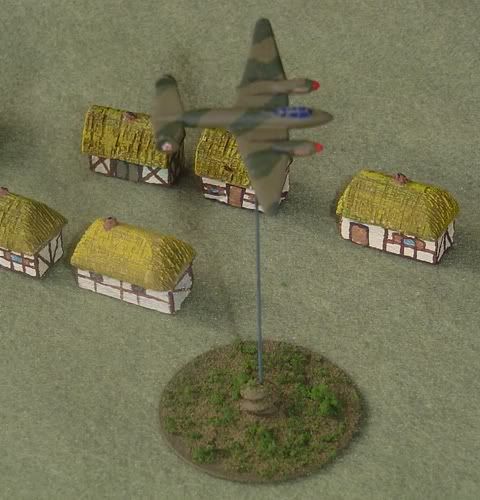I've never done a diorama myself. So I don't speak (type) with the voice (fingers) of experience on the aspects of creating one.
But I know what I like to look at.
I think you've done a fine job. And I think maybe I spy a bear in the corner of the woods -- but what is he doing?*
To the point of 1COC's comment on the aircraft mount ... this is a difficult issue in micro-armor scales. The key is to reduce the visibility of the mounting to the point were a viewer either doesn't notice it, or can pretend he doesn't notice it. For diorama purposes, I think the hanging-by-a-wire may be a great solution. I've seen clear plastic stands used, but frankly I don't think they work as well.
I use stiff wire stands (thinner than the soft-metal stands commonly sold for micro-armor aircraft). I paint them in a low-visibility color -- usually medium to dark gray. They are not AS visible, but they are still visible.

Here are some Italian Macchi c200's on my stands. As mentioned, I don't do dioramas, so this picture is from a set-up of my wargaming terrain. The stands are not highly visible, but still too visible for diorama purposes. Or at least, for photography of dioramas.
One advantage of the stiff-wire mounting is that the wire can be inserted directly into a diorama base. In my case, for wargaming, I need to have a larger stand-base, as seen here:

My aircraft bases are made from rotary-drill sanding disks which I buy at the auto-parts store for about $0.20, and then paint and flock.
This solution is practical for wargaming, but not quite optimal for visual purposes. When I photograph my aircraft in the wargaming environment, I often construct my pictures to use the wings, fuselage, and edges of the picture to hide the stands. This creates a more visually appealing image. I would suggest considering this for photographing dioramas, and then removing the wire mount when viewing the ground under the aircraft.
Some examples:

One of the Macchi's again, this time hiding the stand.

An SM.79 bomber, hiding the stand. Again, not a diorama. This picture is taken over one of CG Erickson's terrain boards during a day of wargaming.
Hope that helps.
-Mark 1
*Note: I put that bit of hidden levity in to highlight an issue I've seen on many successful dioramas. Some random detail, or even whimsical detail, that is not obvious unless one studies the diorama, often adds great interest. If you look at dioramas in the popular modelling magazines, you'll often see this. Somebody reading a newspaper in a combat zone, a dog lifting his leg on the back of a tank, a guy on the radio in the background, a dear looking out of the bushes as the truck roles by... these are the kinds of details one sees in the larger scale dios. It would be hard to do the same in micro scale, but we can take the same idea. So some infantry checking out the woods, or a bomb crater just a few meters behind the APC, or a rapelling rope hanging from the 'copter, any of these details reward the viewer when he studies the diorama closely. Just a notion.
And btw, I do know what the bear does in the woods. No need to answer that question.











